Gezeiten’s biotech skincare works in harmony with your circadian rhythm
Gezeiten uses biotechnology to create skincare products that harness the body’s natural rhythms

Gezeiten is a new skincare brand that takes its name from the German word for the ebb and flow of the sea tides. It is a fitting name, not only because the German-born brand uses marine extracts and mineral-rich, sub-oceanic water concentrate to create its products. But also because they are tailored to work harmoniously with the body’s natural rhythms for optimal results.
Gezeiten uses biotechnology to create skincare for the ‘new age’

The brand was founded by two families: husband and wife Michaela and Michael Hiltebrandt, who work on research and product development with scientists and academics, and creative brother and sister duo Charles and Claire Zurheide Bals. Collectively, they were drawn together by a belief that the skincare market is oversaturated with products, few of which deliver the results they promise. So they joined forces in the hopes of hitting on the secret that other brands were missing. ‘We are interested in exploring human origins and revisiting how our skin functions as an organism,’ says the team over email. ‘And also where we are headed, as human kind. This is precisely what has really driven our scientific journey with Gezeiten.’

The result is a range of five products: a day cream, a night cream, a protecting serum, a rejuvenating serum and a seven-day treatment set. Each is formulated with the brand’s patented Earth Marine Celltech Complex, which is designed to prevent skin ageing at a cellular level by replenishing the skin barrier, supporting the skin’s natural healing process, detoxifying and hydrating.
The brand worked with biotech and marine biology experts to ensure that the formulation works; but they also recognised that to create truly cutting-edge and effective skincare, they had to ensure the ingredients were delivered to the skin at the most opportune moments. To do that, they developed daytime and nighttime formulations with time release functions to support the skin’s specific needs during the daytime ‘stress phase’ and the nighttime ‘regeneration phase’.

By incorporating chronobiology (the study of the body’s rhythms) into the formulations, Gezeiten ensures that the products work to fill in the gaps a demanding, urban life creates, particularly when it comes to our disrupted sleep cycles. ‘A major problem of our modern lifestyle is a disturbed circadian rhythm, which leads to skin disorders such as hypersensitivity of the skin, inflammation, eczema, and ultimately premature skin ageing,’ say the Gezeiten team.

‘We are focusing on synchronising disrupted circadian rhythms to maintain overall skin health,’ they continue. ‘Sleep is important, but so is the quality of sleep and the stress we are exposed to. Cortisol levels also harm the skin, as does our lifestyle. The world has changed so much over the thousands of years and the skin is still the same. It is the interplay of different components that determines the quality and health of the skin. We take them all into account in the development of our current and future products.’

After a month of use, the skincare starts syncing with the skin’s natural 28-day regeneration cycle, with a noticeable reduction of fine lines, wrinkles, and hyperpigmentation, as well as an increase in moisture.
Receive our daily digest of inspiration, escapism and design stories from around the world direct to your inbox.
‘Our approach has led us to look at skin from a 360-degree point of view,’ says Gezeiten. ‘So observing how the body works, active ingredients, the latest technologies on the market, and taking sustainability into account at every step, we have created a skincare range, but also the blueprint of skincare for the new age.’
Mary Cleary is a writer based in London and New York. Previously beauty & grooming editor at Wallpaper*, she is now a contributing editor, alongside writing for various publications on all aspects of culture.
-
 Year in review: the shape of mobility to come in our list of the top 10 concept cars of 2025
Year in review: the shape of mobility to come in our list of the top 10 concept cars of 2025Concept cars remain hugely popular ways to stoke interest in innovation and future forms. Here are our ten best conceptual visions from 2025
-
 These Guadalajara architects mix modernism with traditional local materials and craft
These Guadalajara architects mix modernism with traditional local materials and craftGuadalajara architects Laura Barba and Luis Aurelio of Barbapiña Arquitectos design drawing on the past to imagine the future
-
 Robert Therrien's largest-ever museum show in Los Angeles is enduringly appealing
Robert Therrien's largest-ever museum show in Los Angeles is enduringly appealing'This is a Story' at The Broad unites 120 of Robert Therrien's sculptures, paintings and works on paper